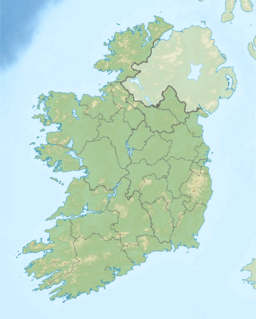Cullahill Mountain facts for kids
Quick facts for kids Cullahill Mountain |
|
|---|---|
| Knockmannon Hill, Culla Hills | |
| Highest point | |
| Elevation | 313 m (1,027 ft) |
| Prominence | 151 |
| Listing | Marilyn |
| Naming | |
| Native name | Sliabh na Cúlchoille (Irish) |
| English translation | Mountain of the Hazel Wood |
| Geography | |
| Location | County Laois |
| Country | |
| OSI/OSNI grid | S379710 |
| Topo map | OSi Discovery 68 |
Cullahill Mountain (which means "Mountain of the Hazel Wood" in Irish) is a special hill in County Laois, Ireland. It's known as a Marilyn hill because it's tall enough. It's also a Special Area of Conservation, which means it's protected for its nature.
Cullahill Mountain is about 313 m (1,027 ft) high. It gives its name to the nearby village and area. Sometimes, people also call it Knockmannon Hill. The mountain got its name from an old forest that used to cover the hill and stretch down to Cullahill Castle. Records from the 1400s and 1500s mention the area with names like "na Cúlchailli" and "Cowlekyll".
Today, Cullahill Mountain has a walking trail. You can find rare plants like the Green-winged Orchid here. On the lower parts of the hill, there's a forest with Ash and Hazel trees. The mountain is located on the Castlecomer Plateau, near the main N8 road. It's between Durrow in County Laois and Johnstown in County Kilkenny.
Contents
Exploring Cullahill Mountain
Where is Cullahill Mountain?
County Laois has a flat middle area, but it also has some hills. These include the Slieve Bloom Mountains and Cullahill Mountain. Cullahill Mountain is on the western side of the Castlecomer Plateau. It marks the northern edge of a valley that goes from Ballyragget to Freshford. You can find it off the M8 motorway. It's about 15 km northeast of Urlingford and Johnstown, County Kilkenny. Or, you can go southwest from Durrow, County Laois along the R639 road.
Why is it a Special Area?
Cullahill Mountain is a Special Area of Conservation because of its important natural features. This protection comes from a European Union rule called the Habitats Directive. The site is home to many Green-winged Orchids. This is a rare flower that is protected by Irish law.
The grasslands on the mountain are full of different kinds of orchids. You can see Twayblade, Frog Orchid, Bee Orchid, and Early-purple Orchid. The western side of the mountain has a forest with Ash and Hazel trees.
Most of the plants on the mountain grow in herb-rich grassland over limestone rock. This area has about 5 types of grass, 2 types of sedges, and 20 types of broad-leaved plants. This rich plant life helps many different insects to live there. Some grasses you might see include Quaking-grass, Crested Dog's-tail, Sheep's-fescue, Downy Oat-grass, and Yellow Oat-grass. Among these grasses, you can find plants like Mouse-ear Hawkweed, Wild Thyme, Bird's-foot-trefoil, Lady's Bedstraw, Carline Thistle, Mountain Everlasting, Purging Flax, and Eyebright.
Fun Things to Do
Walking Trails
There is a beautiful walking trail on Cullahill Mountain. It goes through forests and farmland. This trail was created with help from local groups. The walk starts in Cullahill village. It's about 10 km long and follows paths through fields, forest tracks, and small roads.
As you walk, you'll pass Cummer Well and an old ring fort. The trail goes along the low hills above Cullahill village. From the mountain, you can see amazing views. You can look out towards the Slieve Bloom Mountains to the northwest. To the southwest, you might see the Comeraghs and Galtees. To the east, you can spot the Blackstairs and Wicklow Hills. Other mountains like Keeper Hill and Slieve na mBan can also be seen.
Other Activities
Some people also enjoy off-road cycling in the area around Cullahill Mountain. It's a great place to explore nature and get some exercise.


